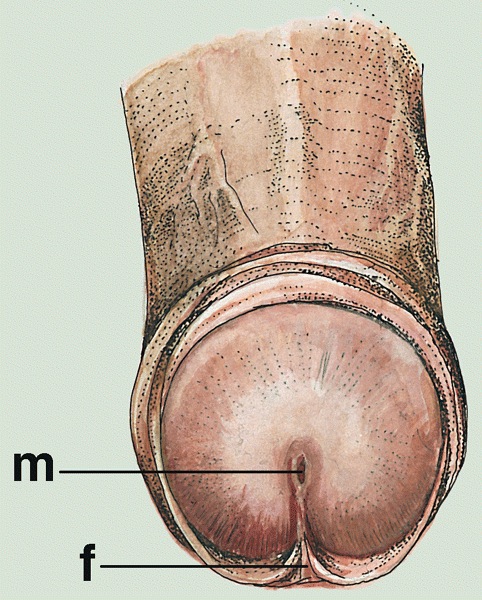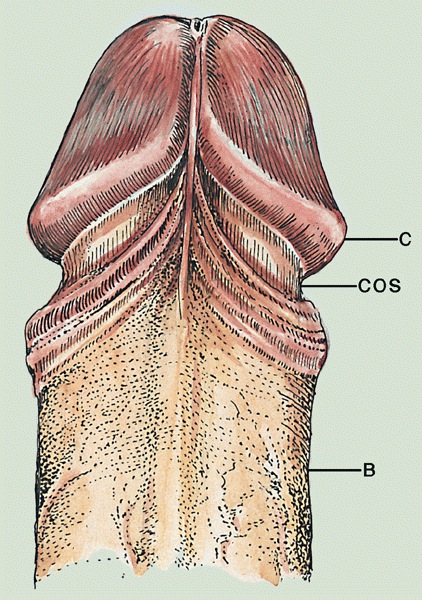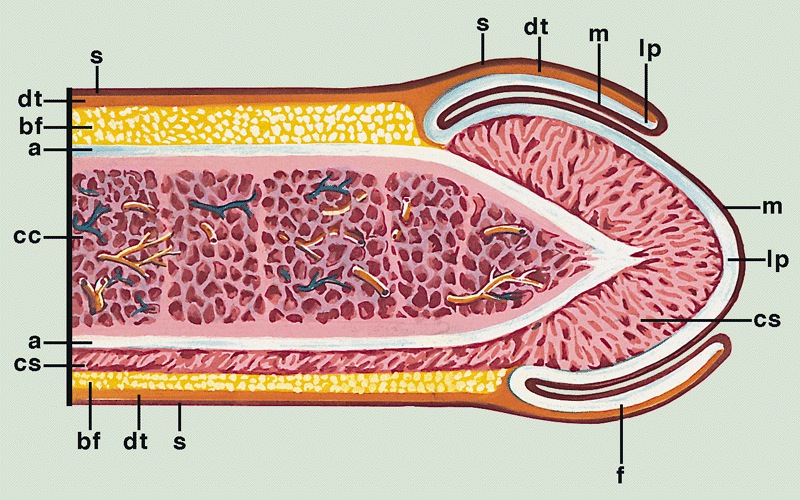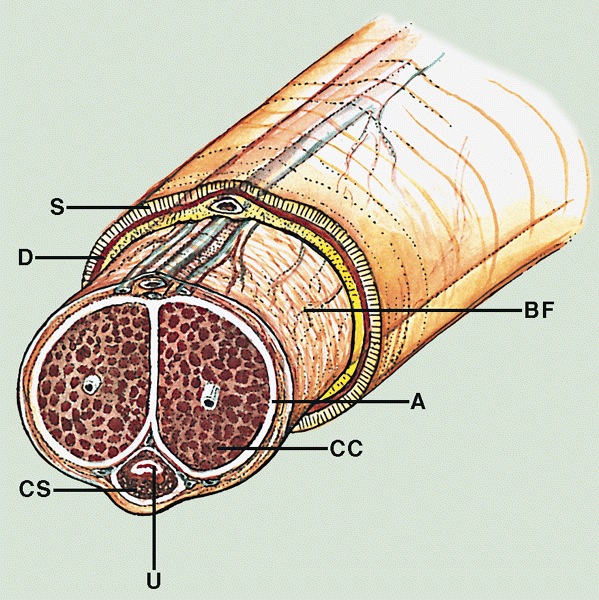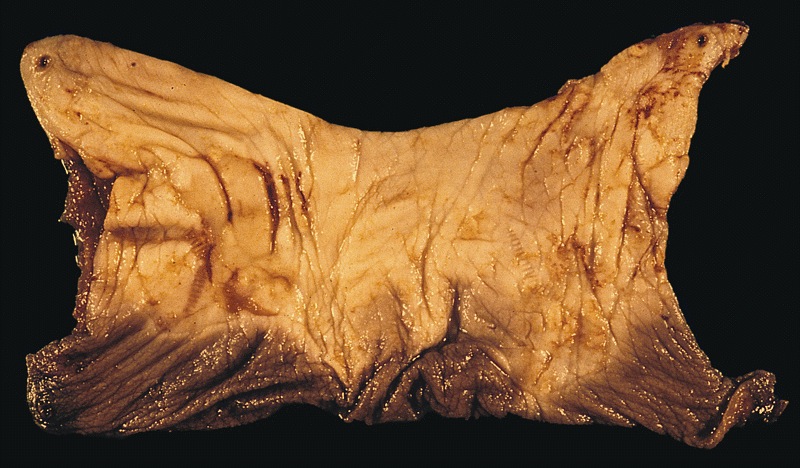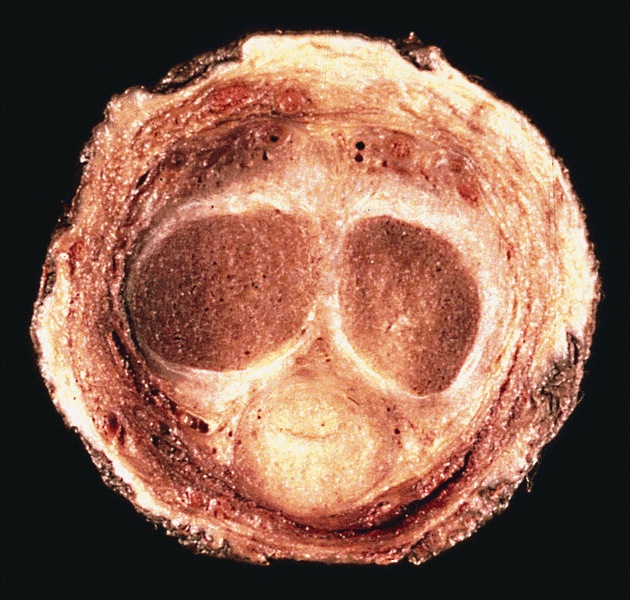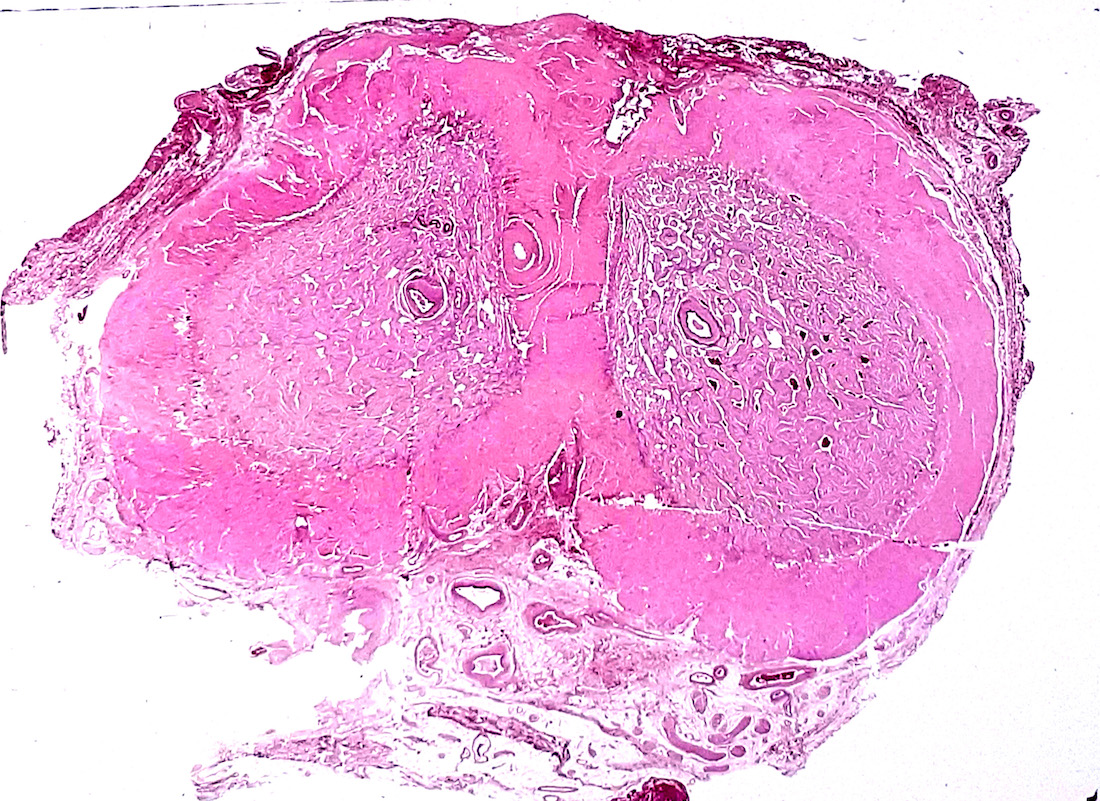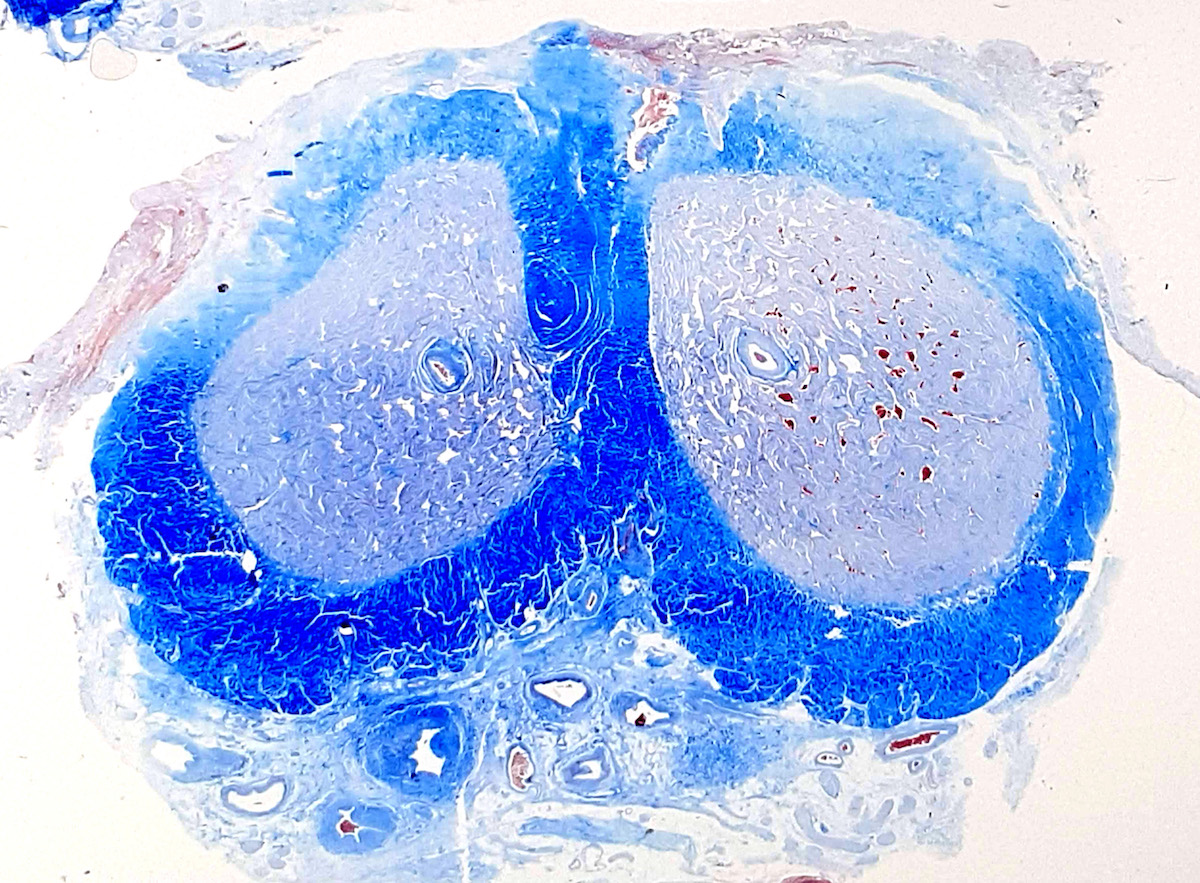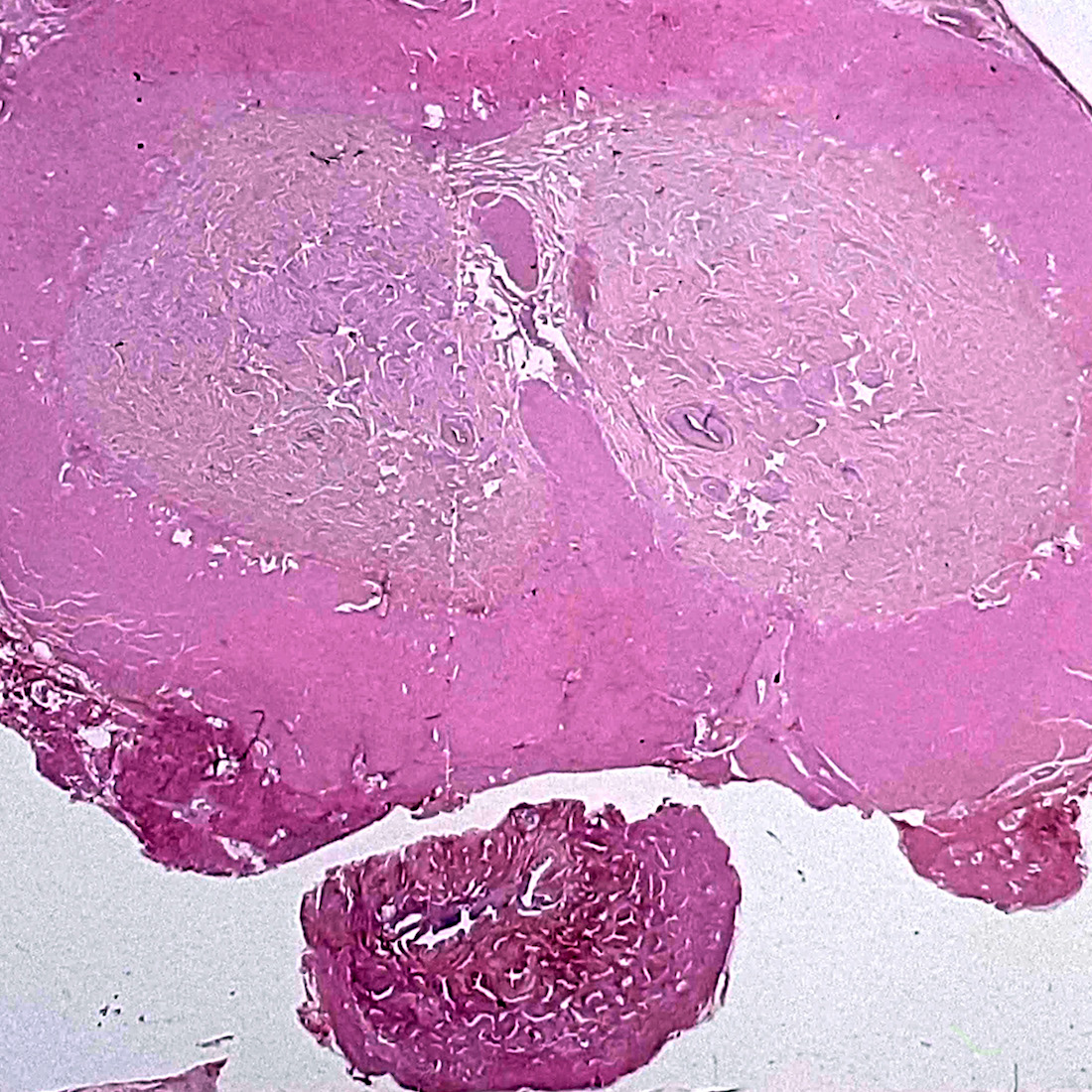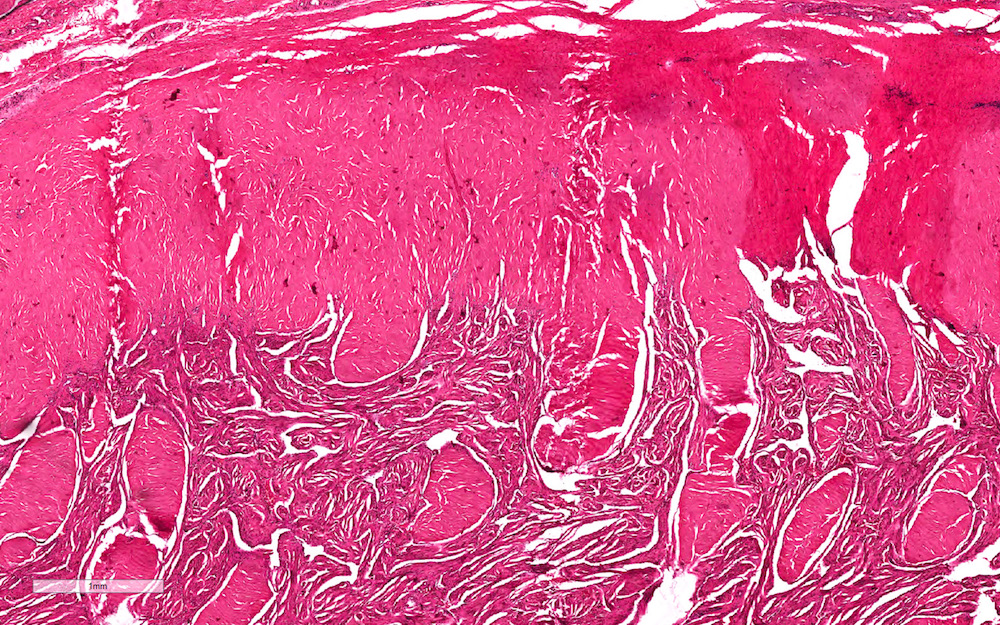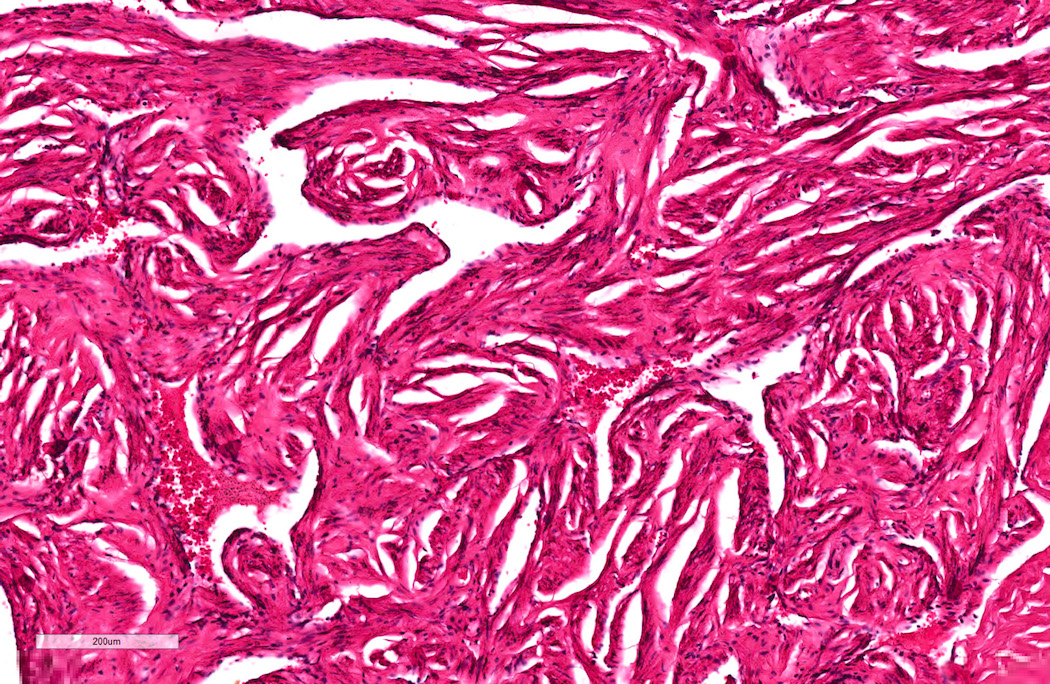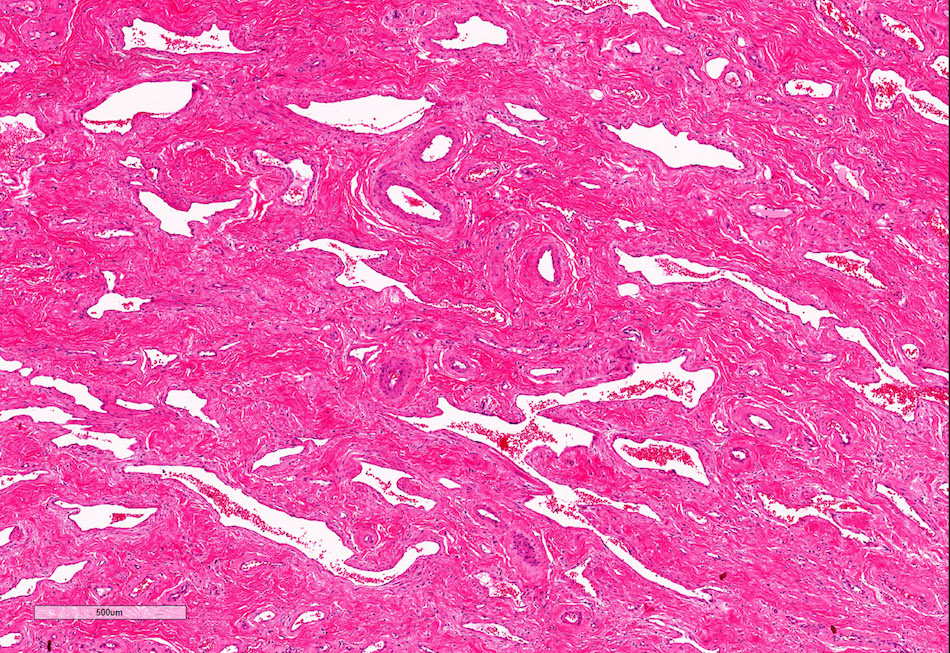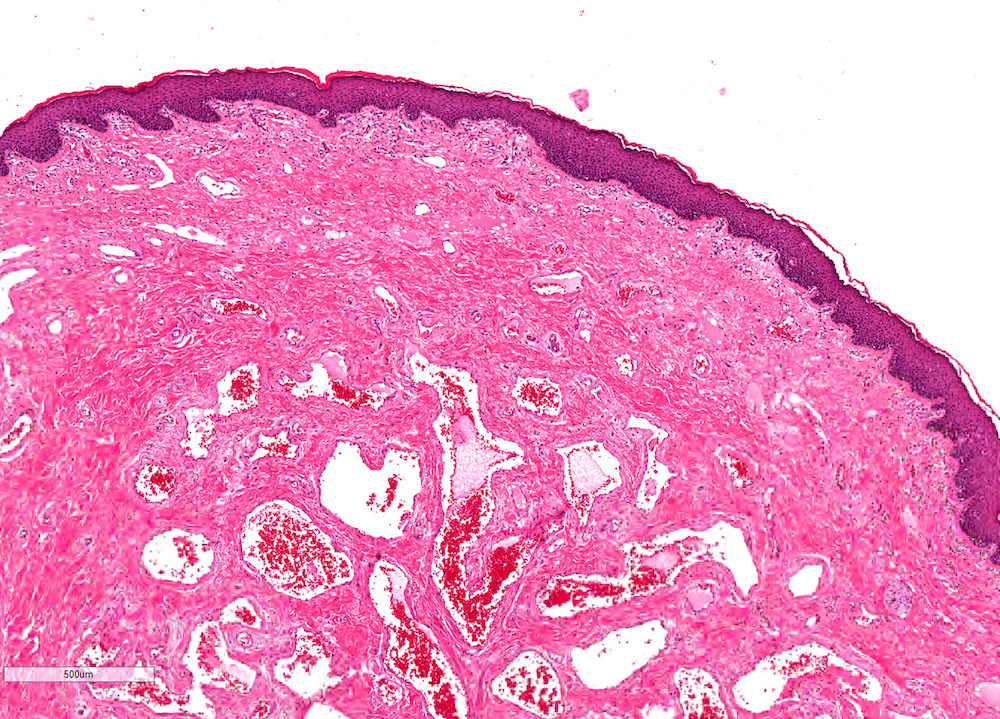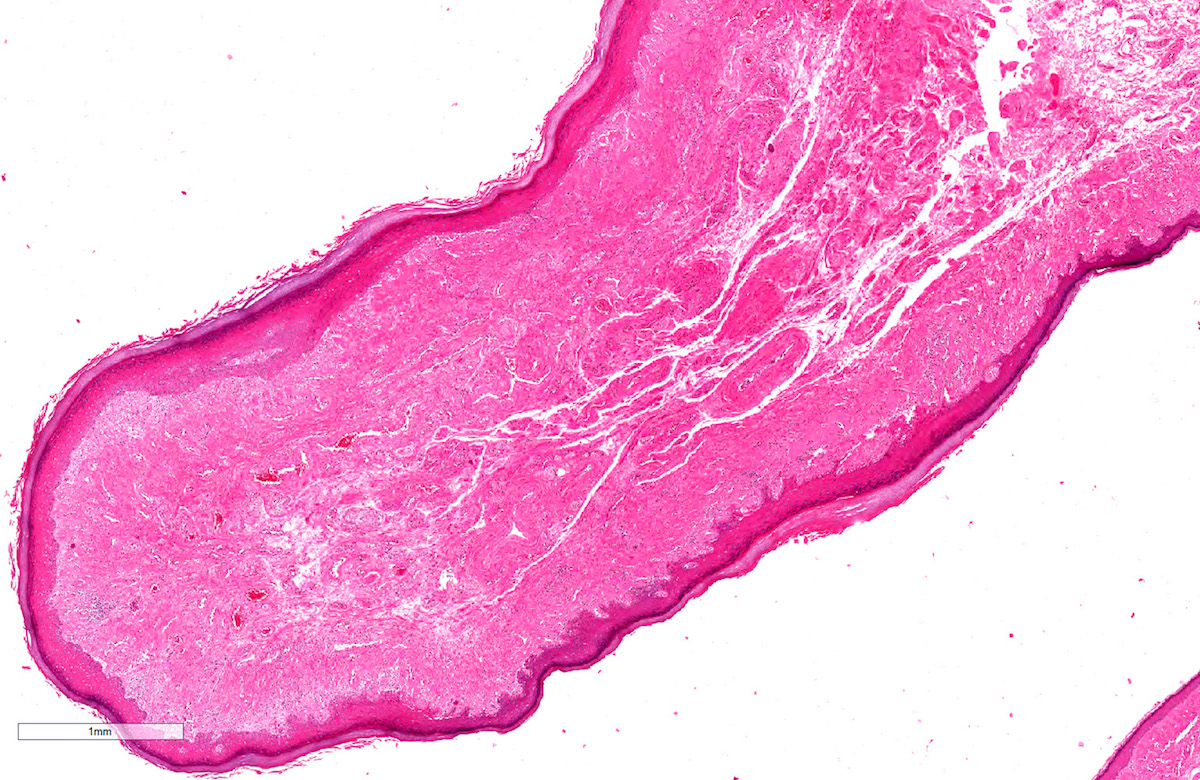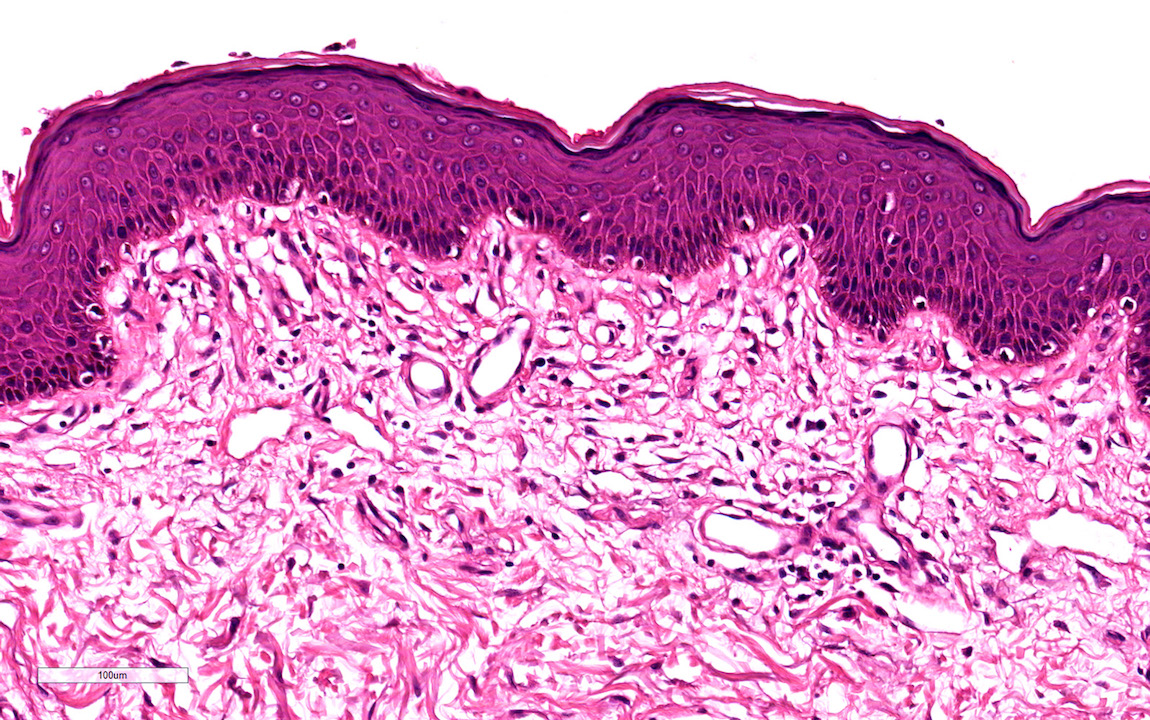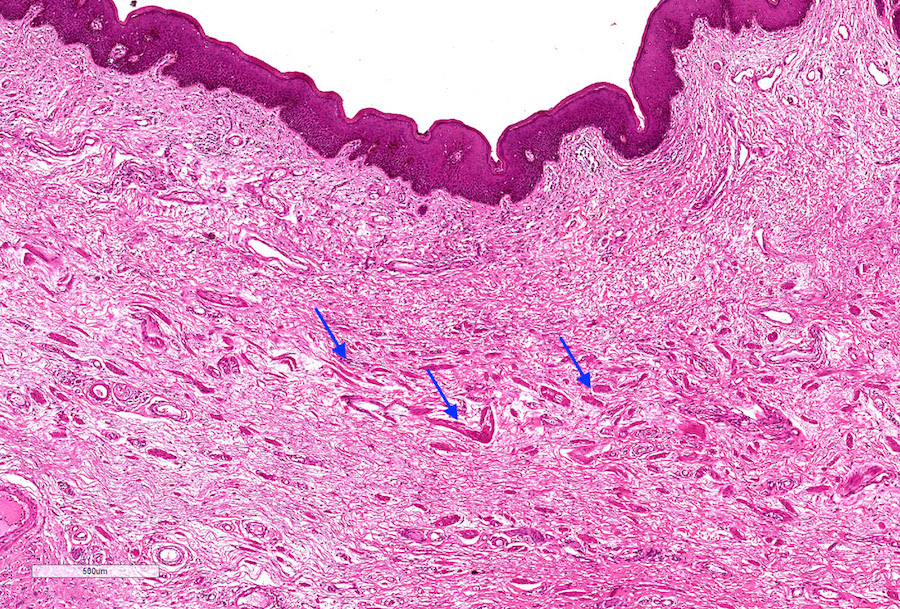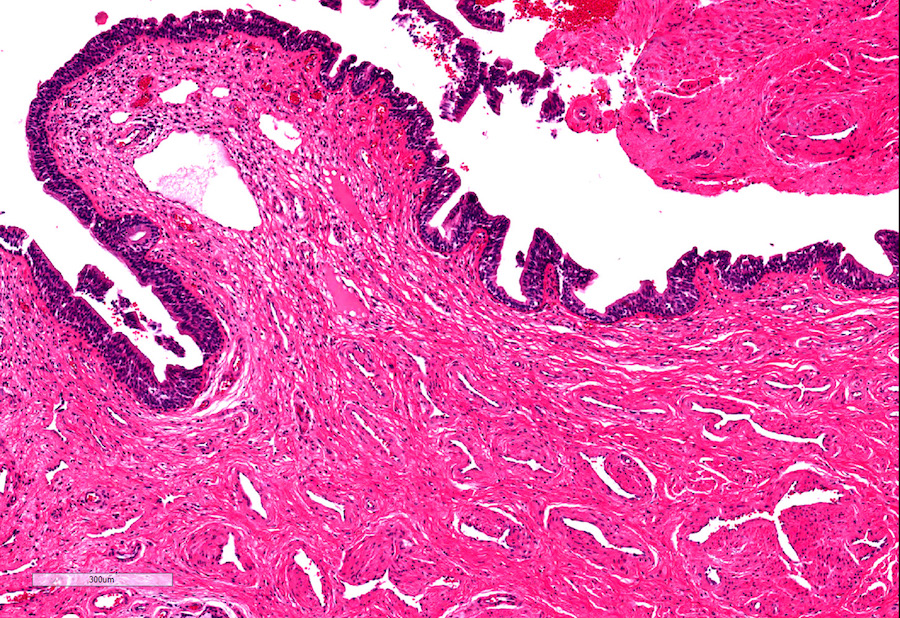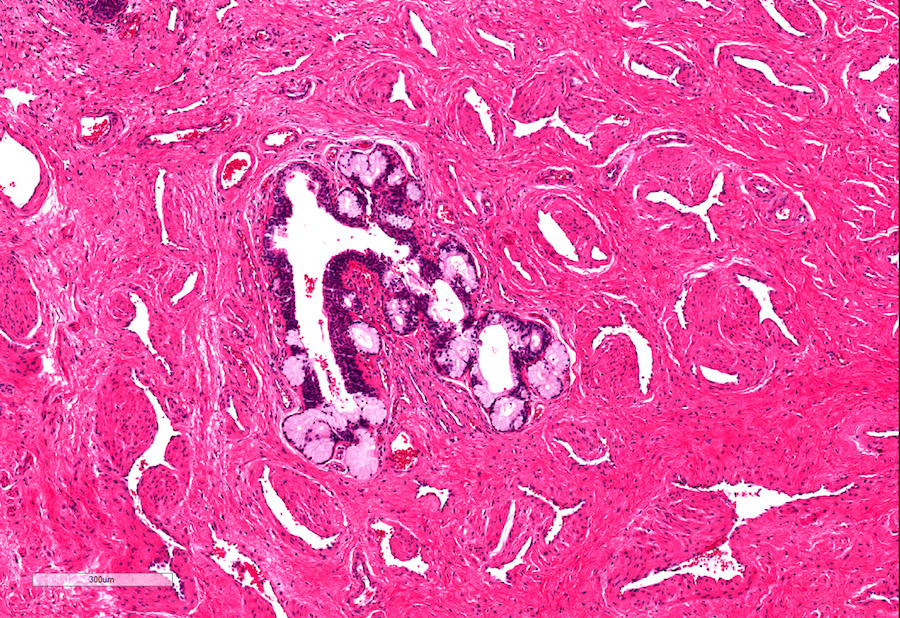Table of Contents
Definition / general | Essential features | Terminology | Physiology | Diagrams / tables | Clinical features | Gross description | Gross images | Microscopic (histologic) description | Microscopic (histologic) images | Virtual slides | Positive stains | Negative stains | Additional references | Practice question #1 | Practice answer #1 | Practice question #2 | Practice answer #2Cite this page: Sanchez DF, Cubilla AL. Anatomy & histology-penis. PathologyOutlines.com website. https://www.pathologyoutlines.com/topic/penscrotumanat.html. Accessed September 16th, 2025.
Definition / general
- Cylindric organ suspended from front and sides of pubic arch
- Mainly composed of erectile corpora
- Contains majority of urethra
- Orientation: the upper surface is termed dorsal, the undersurface is termed ventral
Essential features
- Glans and foreskin are the most important anatomic sections of the penis for clinical practice
- 3 erectile tissues: 2 corpora cavernosa (dorsal), 1 corpus spongiosum (ventral)
- Foreskin lacks skin adnexa
Terminology
- There are 3 main parts
- Proximal root
- Middle body (corpus or shaft)
- Distal glans (head)
- Root
- Erectile tissues: bulb, crura
- Muscles: ischiocavernosus and bulbospongiosus
- Penile shaft / middle body
- 3 cylindrical masses of erectile tissue
- Specialized venous sinuses of variable diameter and widely interconnected
- Bound together by fibrous tunica albuginea
- Penile (Buck) fascia:
- Loose connective tissue between dartos layer and tunica albuginea
- From penile root to coronal sulcus
- Dartos layer:
- Smooth discontinuous muscle layer from homologous scrotal layer
- Throughout entire shaft between dermis and penile fascia
- Reflects itself over the coronal sulcus before continuing to foreskin (~50%)
- Continues directly to foreskin (~50%)
- Tunica albuginea:
- Dense fibrous membrane
- Encasing and separating corpora cavernosa from corpus spongiosum
- From penile root to tips of corpora cavernosa
- Slits containing small vessels, nerves and adipose tissue
- Considered route for cancer spread (Am J Surg Pathol 2017;41:1542)
- Corpora cavernosa:
- 2 lateral masses of erectile tissue that form the bulk of penis; posterior portions are called crura and connect to pubic arch
- Corpus spongiosum:
- Median ventral mass of erectile tissue
- Contains most of urethra
- Male urethra: see Anatomy & histology-male urethra
- Distal penis
- Glans:
- Conical cup covering distal end of penile shaft
- Portion distal to coronal sulcus
- Glans corona:
- At base of glans
- Slightly elevated circumferential rim
- May contain small papillae over its free border (mistaken for Tyson glands, which are absent in humans), especially in sexually active males
- Meatus urethralis:
- Urethral opening
- Usually at central ventral glans penis
- Vertical cleft, related to frenulum (BJU Int 2007;100:161)
- Fossa navicularis:
- Terminal dilated portion of penile urethra
- Stratified, nonkeratinized squamous epithelium with clear cytoplasm
- Frenulum:
- Fibrous band of tissue attaching foreskin to ventral glans
- Coronal sulcus:
- Narrow and circumferential cul de sac (in noncircumcised) behind glans corona
- Area of insertion of dartos and Buck fascia
- Foreskin:
- Skin folded on itself covering the glans (clitoris in females)
- 3 types of foreskin (Am J Surg Pathol 2003;27:994)
- Long (orifice covers the glans)
- Medium (orifice is between meatus and glans corona)
- Short (orifice is between corona and sulcus)
- Layers are inner squamous epithelium, lamina propria, dartos layer and preputial skin
- Incidence of completely retractile foreskin increased from 0% at birth to 42% in adolescence
- Phimosis rate decreased with age from 99.7% to 7% (World J Pediatr 2009;5:312)
- Glans:
Physiology
- 2 main functions
- Urination
- Sexual intercourse
- Erection via parasympathetic innervation
- Muscles compression in the penis root prevent veins from draining erectile corpora
- Enlargement is obtained by erectile corpora filled and pressing against tunica albuginea
- Ejaculation via sympathetic innervation
Diagrams / tables
Clinical features
- Regional lymph nodes
- Superficial inguinal nodes (site of 1 - 3 sentinel nodes)
- Deep inguinal
- External iliac
- Internal iliac (pelvic nodes)
- Periurethral glands
- Cowper (bulbourethral) glands: mucinous acinar structures deep at level of membranous urethra
- Intraepithelial glands (Morgagni lacunae): 1 layer cylindrical intraepithelial glands
- Littre glands: tubuloacinar mucinous glands present along entire length of corpus spongiosum
- Miscellaneous
- Penile glycogenated epithelial cells indicate recent vaginal intercourse (Am J Clin Pathol 1985;84:524)
- Penile swabs after recent vaginal intercourse almost always contain female cells identifiable by FISH (Arch Pathol Lab Med 2000;124:1080)
- Skin at root of penis is continuous with skin over scrotum and perineum
- Erectile tissues of corpus spongiosum are composed of straight thin muscle wall whereas those of corpus cavernosum are interanastomosed and composed of thicker muscle walls
Gross description
- Transversal cut of penile shaft
- Surgical margin
- Must include skin, soft tissues and erectile tissues
- Shaft, longitudinal cut, from surface to deep structures
- Skin
- Penile fascia and dartos
- Albuginea
- Corpora cavernosa
- Corpus spongiosum
- Urethra
- Glans, longitudinal cut, from surface to deep structures
- Squamous mucosa and lamina propria
- Corpus spongiosum
- Urethra and meatus
- Tip of corpora cavernosa with albuginea
- Foreskin
- Anatomical position: folded with skin on the outer surface and mucosa on the inner surface
- Layers: skin, soft tissues with dartos, mucosa (Mills: Sternberg's Diagnostic Surgical Pathology, 6th Edition, 2015
Microscopic (histologic) description
- Skin (Am J Surg Pathol 2017;41:1542, Mills: Histology for Pathologists, 5th Edition, 2019)
- Thin skin covering
- Stratified squamous keratinized epithelium
- Loosely connected to deeper parts of the organ
- Mucosa
- Stratified squamous epithelium
- Up to 10 cell thickness
- Nonkeratinizing at glans penis, keratinized after circumcision
- Lamina propria
- Loose connective tissue
- Small vessels
- Sparse lymphocytic infiltrate
- Penile fascia
- Loose connective tissue
- Small arteries, dorsal veins and nerve bundles
- Adipose tissue
- Corpora cavernosa
- Interanastomosed vascular spaces
- Thicker muscle wall
- Corpus spongiosum
- Vascular spaces
- Straight thin muscle wall
- Abundant elastic fibers
- Urethra
- Prostatic urethra: urothelium
- Membranous urethra: stratified or ciliated pseudostratified columnar epithelium
- Penile urethra: stratified or ciliated pseudostratified columnar epithelium
- Foreskin
- Inner foreskin: continues glans squamous mucosa
- Outer foreskin: squamous keratinized epithelium with no adnexa
- Loose connective tissue with discontinuous smooth muscle bundles (dartos)
Microscopic (histologic) images
Contributed by Diego F. Sanchez, M.D. and Antonio L. Cubilla, M.D.
Positive stains
- CD117: c-kit positive interstitial cells, similar to those in gut (J Sex Med 2007;4:66)
- CK7: urethral upper epithelial layer
- p63 and 34 beta E12: urethral basal layer is positive (Mills: Histology for Pathologists, 5th Edition, 2019)
- GATA3: both urethral layers (Hum Pathol 2013;44:2760)
- PSA: occasional urethral glands (Hum Pathol 2002;33:905)
- CK6: foreskin all layers (Differentiation 2018;103:86)
- CK10: foreskin suprabasal layers (Differentiation 2018;103:86)
Negative stains
- CD20: urethral superficial and basal lining (Hum Pathol 2013;44:2760)
- p63: urethral superficial lining
Additional references
Practice question #1
Practice answer #1
D. Smooth muscle (dartos) represented by discontinuous fascicles intermixed with connective tissue
Comment Here
Reference: Anatomy / histology of penis
Comment Here
Reference: Anatomy / histology of penis
Practice question #2
- What is the epithelium of the penile urethra classified as?
- Pseudostratified columnar
- Simple columnar
- Simple cuboidal
- Simple squamous
- Urothelium
Practice answer #2




